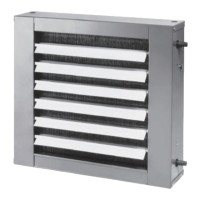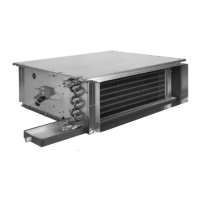96 UNT-SVX07B-EN
Start-Up
Data Sharing
Because this controller utilizes LonWorks™ technology, the controller can send or receive data
(setpoint, heat/cool mode, fan request, space temperature, etc.) to and from other controllers on
the communication link, with or without the existence of a building automation system. This
applies to applications where multiple unit controllers share a single space temperature sensor (for
rooms with multiple units but only one zone sensor) for both standalone (with communication
wiring between units) and building automation system applications. For this application you will
need to use the Rover service tool. For more information on setup, refer to the Trane publication
EMTX-SVX01G-EN, or the most recent version.
Binary Inputs
The Tracer ZN520 controller has four available binary inputs (see Tabl e 2 6 ). Normally, these inputs
are factory-configured for the following functions:
• Binary input 1: Low temperature detection (freezestat)
• Binary input 2: Condensate overflow
• Binary input 3: Occupancy/ Generic
• Binary input 4: Fan status
Note: Th
e generic binary input can be used with a Tracer Summit® building automation system
only.
Each binary input default configuration (including normally open/closed) is set at the factory.
However, you can configure each of the four binary inputs as normally open or normally closed.
The controller will be set properly for each factory-supplied binary input end-device. When no
device is connected to the input, configure the controller’s input as not used.
Binary Outputs
Binary outputs are configured to support the following:
• Three fan stages (when one or two fan stages are pr
esent, medium fan speed can be configured
as exhaust fan)
• One hydronic cooling stage
• One hydronic heating stage (dehumidification requires this to be in the reheat position)
Table 26. Binary input configurations
Binary Input Description Configuration
Controller Operation
Contact Closed Contact Open
BI 1 Low temperature detection
(a)
(a) During low temperature, condensate overflow, and fan status diagnostics, the Tracer ZN520 control disables all normal
unit operation of the fan, valves, and damper.
Normally closed Normal Diagnostic
(b)
(b)Table 27, p. 97 shows the controller’s response to low temperature detection, condensate overflow, and fan status diag-
nostics.
BI 2 Condensate overflow
(a)
Normally closed Normal Diagnostic
(b)
BI 3 Occupancy Normally open Unoccupied Occupied
BI 3 Generic binary input Normally open Normal
(c)
(c) The generic binary input does not affect unit operation. A building automation system reads this input as a generic binary
input.
Normal
(c)
BI 4 Fan status
(a)
Normally open Normal Diagnostic
(d)
(d)If the fan mode input is in the off position or the controller is in the unoccupied mode with the fan off, the fan status input
will be open. A diagnostic will not be generated when the controller commands the fan off. A diagnostic will only be generated
if the fan status input does not close after one minute from energizing a fan output or any time the input is open for one
minute. The controller waits up to one minute after energizing a fan output to allow the differential pressure to build up
across the fan.
Note: The occupancy binary input is for standalone unit controllers as an occupied/unoccupied input. However, when the
controller receives a communicated occupied/unoccupied request, the communicated request has priority over the
hardwired input.

